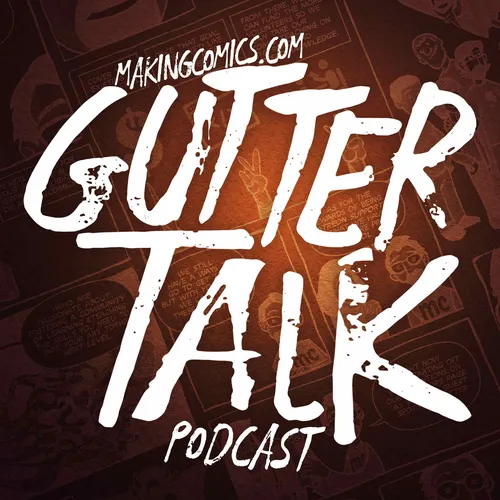96: Patrick Yurick (ComicFuel 2) – MakingComics.com Gutter Talk Podcast
- Author
- MakingComics.com
- Published
- Fri 10 Jun 2016
- Episode Link
- https://makingcomics.com/2016/06/10/comicfuel2/
Holy MOLY, what a whirlwind of amazingness it has been in the time between the release of episode 1 of Comic Fuel and Episode 2! We have had a thousand people download and listen to the episode and I have enough questions that I have to wait for another four episodes before I can put out another call for questions. Wow.
In this episode, episode 2, we’ll discuss project management, the comic creation process, coloring comics, penciling comics, and hosting comics online. The questions came from places like Ireland, India, Brazil, California, and Indiana. For legit #comicfuel we’ll hear about why we do art from Stephen McCranie, transitioning into fame and what is at the core of what artistry is really about from “How I Met Your Mother” actor Josh Radnor, and we’ll also hear about the art of really listening by famed audio producer Chris Watson.
Questions answered in this episode (jump-to specific question times listed below)
- How many pages should a comic issue be to be printed?
- How long would it take to make a comic by yourself; scripting, storyboarding, art and lettering; and self publish it?
- How do you keep up momentum on making comics?
- How long does it take for a comic book artist to make a comic book?
- What is the step-by-step process I should go through to choose colors that will look good?
- What kind of colors can i use?
- Am I just not being patient enough with myself, or am I trying to fit too much, too zoomed out, into one panel?
- What websites are best for starting to post a webcomic?
Another big announcement is that I spent a lot of time this month creating the Comic Fuel Podcast Wiki (http://comicfuel.wikidot.com/) which will serve as a repository for all questions, notes, and links that are mentioned in the show. Check it out. It took me FOREVER to make, but I’m really proud of it.
The show notes for Episode 2 are at: http://comicfuel.wikidot.com/wiki:episode-2
Jump times to go to different parts of the podcast:
- (00:00) Show Opener
- (00:44) Show Introduction
- (06:43) #ComicFuel Break #1: Chris Watson on The Art of Listening
- (14:25) Question 1: Project Management
Question 1 from Kevin in Eire: How do you keep up momentum on making comics? I make a lot of progress when i take a class or a mooc, but when it’s over I feel a bit like OK where to next?
- (22:55) #ComicFuel Break #2: Stephen McCranie Asking Why We Do Art
- (31:55) Questions 2, 3, & 4: Comic Creation Process Overview
Question 2 from Anjali in Bangalore, India: How long would it take to make a comic by yourself; scripting, storyboarding, art and lettering; and self publish it?
Question 3 from Nate in Brazil: As an independent artist who primarily works with digital comics, I’m interested in publishing my material, but I’m afraid the format won’t translate as well, and I’ll need to cut many pages from chapters so it could fit into what the market deems ideal for print. How many pages should a comic issue be to be printed?
Question 5 from Andrew: How long does it take for a comic book artist to make a comic book?
- (40:40) #ComicFuel Break #3: Josh Radnor Talking About Transitioning as an Artist
- (44:30) Questions 5 & 6: Coloring
Question 5 from Alan: If I have an uncolored comic page, what is the step-by-step process I should go through to choose colors that will look good?
Question 6 from Anonymous: I am not professional in using coloring applications like photoshop and gimp If i ‘d like to do it manually, what is your advice to me, what is kind of colors can i use?
- (51:13) Patreon Ad: Spotlight on Scott Bachman
- (53:58) Question 7: Penciling
Kiana, Indiana: So, I adore sketching pretty much everything, It’s what I spend the majority of my time doing! Although, when I attempted to begin penciling my comic, I found it to be tedious and frustrating? It seems that whatever I try to draw ends up too small to look nice or have any detail. Am I just not being patient enough with myself, or am I trying to fit too much, too zoomed out, into one panel?
- (1:02) How You Can Help Comic Fuel
- (1:04:40) Question 8: Hosting a Comic Online
Question 8 from Julia in California: What websites are best for starting to post a webcomic?
- (1:19:05) Show Outro
Media Used:
Intro & Outro Songs:
“Unexpected Hoedown In Bagging Area” by Dr. Turtle, used under CC BY / Desaturated from original
#ComicFuel Segment #1
“The Kid In The Bins” by Dr. Turtle, used under CC BY / Desaturated from original
Chris Watson interview – The Art of Listening by SNYK RADIO is licensed under a Creative Commons License.
#ComicFuel Segment #2
“Dry Run Well” by Dr. Turtle, used under CC BY / Desaturated from original
Stephen McCranie Interview Gutter Talk Ep. 64 is owned by MakingComics.com
Patreon Info Segment:
“Story To Fall Through” by Dr. Turtle, used under CC BY / Desaturated from original
#ComicFuel Segment #2
“Dry Run Well” by Dr. Turtle, used under CC BY / Desaturated from original
JOSH RADNOR discusses art, film, TV, happiness, and knocking heads with the Dalai Lama. by EMPLOYEE of the MONTH is licensed under a Creative Commons License.

